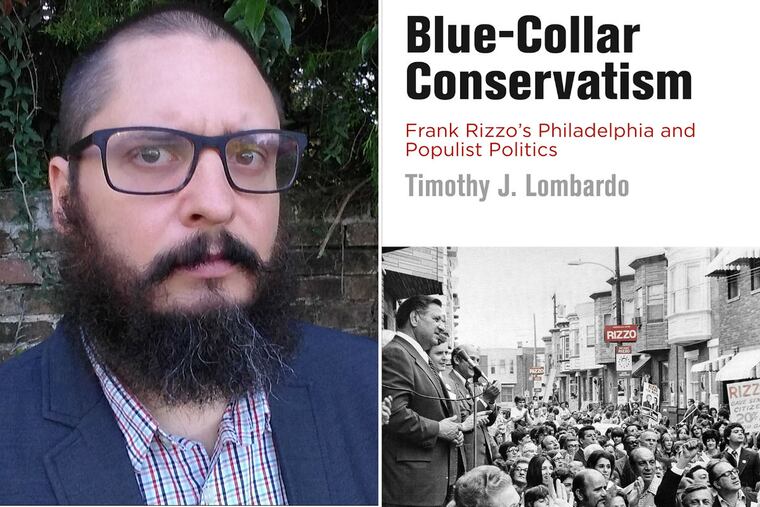Timothy J. Lombardo’s ‘Blue-Collar Conservatism’: Frank Rizzo’s rise, amid class and race antagonisms that swept city and country
Frank Rizzo's rise to power is familiar enough. But this book argues that Rizzo rode a kind of white conservatism based on class and race antagonisms that eventually spread throughout the country. Brewing for more than half a century, it may have led to the 2016 election.

Blue-Collar Conservatism
Frank Rizzo’s Philadelphia and Populist Politics
By Timothy J. Lombardo
University of Pennsylvania Press. 328 pp. $37.50.
Reviewed by John Timpane
Reading this detailed, lucid book, you’re reminded – in fact, you can’t get out of the way – of just how deeply the rise of working-class conservatism in 1960s-70s Philadelphia and throughout the country was anchored in antagonisms of race and class.
Timothy J. Lombardo, a Temple grad who teaches history at the University of South Alabama, writes Blue-Collar Conservatism with detachment, allowing the words, deeds, and images to speak for themselves. It’s one of the great strengths of the book. The writing is straightforward, and the viewpoint seems inarguable. What moves you is the story, even if you know a lot of it already.
And many Philadelphians past and present will. This book does not solely concern Frank Rizzo, although it makes plain how and why he rose to power so rapidly and stayed for so long, first as a beat cop who ultimately became commissioner, then as a two-term mayor. Yet the true protagonist here is the resurgent working-class white population that settled in the city beginning in the 1950s. Blue-Collar Conservatism is a social history of this town and of the changes it underwent after World War II and throughout the turbulent 1960s.
Included are the efforts of liberal reformers such as Joseph Clark, Richardson Dilworth, and Edmund Bacon. They sought to remake the city with programs often both well-intentioned and reasonably successful. Yet ironically, the ethnic working-class whites who flowed into the Northeast and other neighborhoods came to see these reformers as elites out of touch with their own concerns. More is the irony that these ethnic populations actually liked social programs; they just didn’t want people they saw as undeserving to have them. In Bridesburg, Grays Ferry, and elsewhere, a sense arose of separateness, an aggressive defensiveness, including resentment of other groups supposedly grasping at what these truly industrious people felt they had earned.
Meaning, by and large, African Americans. Every change, every social program, seems to have victimized them. The housing initiatives of the 1950s ran aground repeatedly on neighborhood resistance (“urban relocation” became known as “Negro relocation”), failure of city services, and/or disinformation. (Case in point: The unquestioned urban myth that black neighbors would “bring down housing prices,” enforced as truth until it all but became true.) School reform backed up into desperate efforts to keep schools segregated. Low-income housing and affirmative action efforts were seen as threats. Blacks, said one hardworking man, “don’t want what you want.” No, “they want more than you want.”
Such conditions left the field ripe for reframing. Social protest was cast as criminal unrest, and politicians and the police took the mantle of fighters for “law and order,” trenchant social code for “maintenance of racial and class separation.” Politicians of all sides ran on it. Richard Nixon did in 1968 as the country’s cities burned. Rizzo rose through the police ranks to become mayor, largely on his brawny law-keeping promise.
His rise and legacy will be familiar to many local readers. He was a “one of us” political candidate. “For those who felt their neighborhoods, schools, and traditions were at risk,” Lombardo writes, “Rizzo became the answer to their problems.” Photos at the site of the 1969 disturbances at the Tasker Homes low-income housing project in South Philly showed Rizzo in a tux (he’d been at a power party at the Bellevue Stratford) complete with billy club. Such images helped cement his already tremendous popularity. He’d become known as “the toughest cop in America.”
His turbulent time as mayor; his often brutal response to unrest; his career, effectively ending with a disastrous, failed bid to change the City Charter: This is the arc of white conservatism that has since become familiar. And so the story moves beyond the boundaries of this book. The word populism once had a lefty ring to it, but by now it has swung well right. Lombardo’s coda makes a point hanging over Blue-Collar Conservatism from the start: The brew of racial resentment and economic anxiety of 1960s and 1970s Philadelphia moved out of the city (as many whites did), out of the working class, out of many other cities, across the land. And it may have led to the election of 2016.